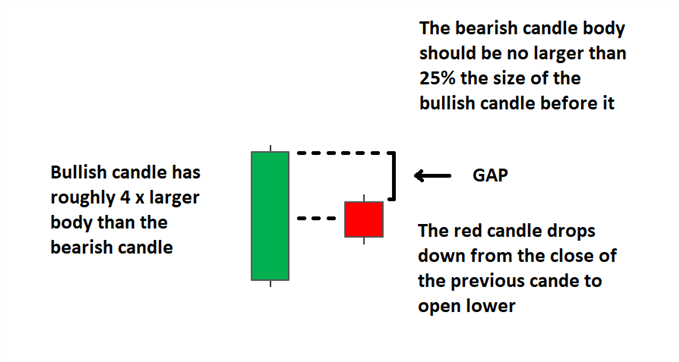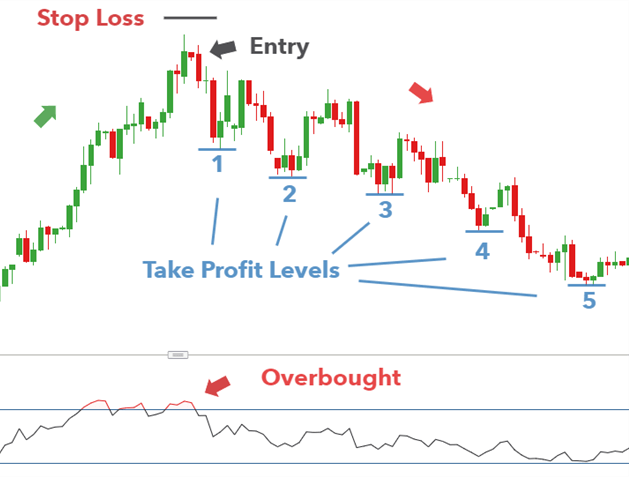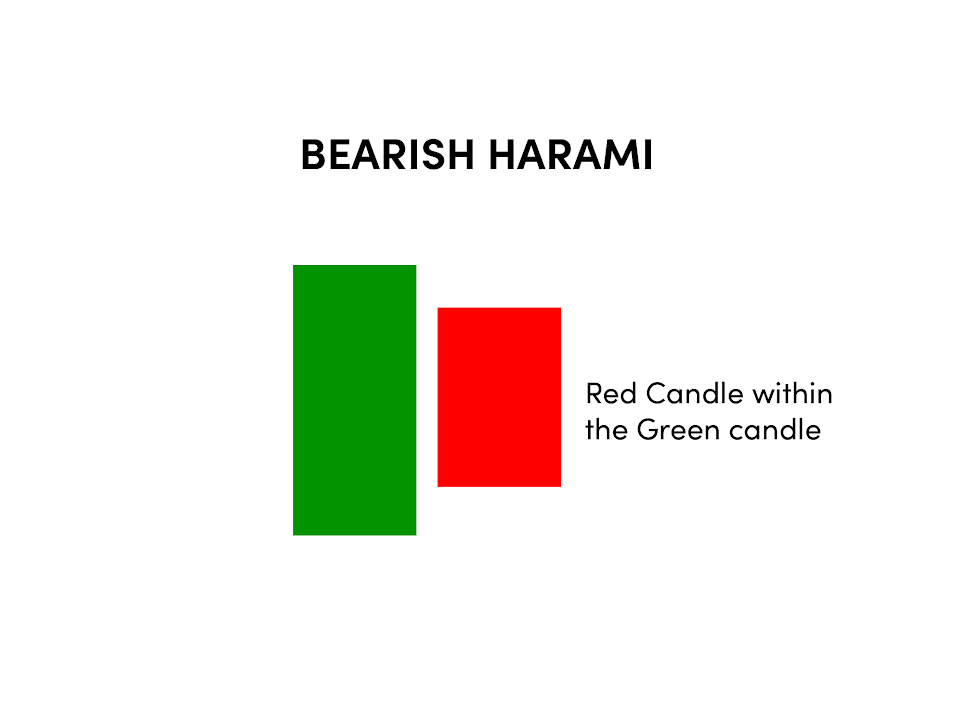The Bearish Harami pattern is a reversal pattern appearing at the top of an uptrend. It consists of a bullish candle with a large body, followed by a bearish candle with a small body enclosed within the body of the prior candle. As a sign of changing momentum, the small bearish candle ‘gaps’ down to open near the mid-range of the previous candle.
-
Sell or short the asset when the second candle closes within the body of the first candle.
-
Set a stop-loss above the high of the first candle.
-
Target a price level that is equivalent to the height of the Bearish Harami pattern.

The opposite of the Bearish Harami is the Bullish Harami and is found at the bottom of a downtrend.
HOW TO IDENTIFY A BEARISH HARAMI ON TRADING CHARTS
Identify existing uptrend.
- Look for signals that momentum is slowing/reversing (stochastic oscillators, bearish moving average crossover, or subsequent bearish candle formations).
- Ensure that the body of the small red candle measures no more that 25% of the previous bullish candle. Stocks will gap down, showing the red candle mid-way down the previous candle. The gap is likely not found in forex candlesticks as they will mostly open at the same level as the prior candle’s close or very close to it.
- ]Observe that the entire bearish candle is enclosed within the length of the previous bullish candle’s body.
- Look for confluence with the use of supporting indicators, key levels of resistance or other supporting evidence to support the trade.
- It’s important to note, the Bearish Harami candlestick pattern will look different when observing it on a stock chart compared to the 24-hour forex market. Below we explore the formation of the pattern on both.
Formation of the Bearish Harami Pattern in the Forex market
The forex market operates on a 24/5 basis which means when one candle closes, another opens at virtually the same level as the previous candle’s closing price. This is often observed under normal market conditions but can change during periods of high volatility. The Bearish Harami pattern in forex will often look something like this:

The small red candle opens close to, or at the level that the prior bullish candle closed at. This is typically observed in the forex market.
Formation of the Bearish Harami Pattern in Stocks
Stocks, on the other hand, have specified trading hours during the day and are known to gap down at the open for many reasons. Some of those might be:
- Negative company news was released after the close of trade
- Country/sector data – viewed via an economic calendar – which is worse than expected.
- Regulatory changes that will negatively affect future earnings
- General (negative) market sentiment
Therefore, the more traditional Harami pattern appears, as seen below for FTSE 100 stock, Lloyds Banking Group PLC:

Notice how there are numerous areas on the chart where the market has gapped – showing wide open spaces between candles. This is often observed in the stock market.
HOW TO TRADE THE BEARISH HARAMI CANDLESTICK PATTERN
Traders can adopt the Bearish Harami 5-step checklist mentioned earlier in the article. Looking at the USD/SGD chart from earlier, we can observe the following:
- There is a clear uptrend.
- The RSI provides an indication that the market is overbought. This could mean that upward momentum is waning however, traders should always wait for the RSI to cross back over the 70 lines for confirmation.
- The bearish candle is no more than 25% the length of the previous candle.
- The bearish candle opens and closes within the length of the previous candle.
- This Bearish Harami appears at a new high so traders should be aware that the market has turned lower from even lower highs previously. Subsequent price action also helps support the new downward momentum indicated by the Bearish Harami.
Stops can be placed above the new high and traders can enter at the opening of the candle following the completion of the Bearish Harami pattern. Since the Bearish Harami appears at the start of a potential downtrend, traders can include multiple target levels to ride out a new extended downtrend.

FOLLOW WA NOW WhatsApp channel!
[Disclaimer: This article is for informational purposes only and should not be construed as investment advice in any way. financestock.in advises its readers and viewers to consult their financial advisors before taking any money-related decisions.]

